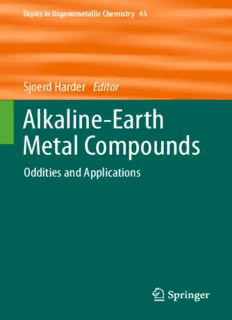
Alkaline-Earth Metal Compounds: Oddities and Applications PDF
Preview Alkaline-Earth Metal Compounds: Oddities and Applications
Topics in Organometallic Chemistry 45 Sjoerd Harder Editor Alkaline-Earth Metal Compounds Oddities and Applications 45 Topics in Organometallic Chemistry Editorial Board: M. Beller J. M. Brown P. H. Dixneuf l l A. Fu¨rstner L. J. Gooßen l P. Hofmann T. Ikariya S. Nolan l l L. A. Oro Q.-L. Zhou l Topics in Organometallic Chemistry Recently Published Volumes InventingReactions IridiumCatalysis VolumeEditor:LukasJ.Gooßen VolumeEditor:P.G.Andersson Vol.44,2013 Vol.34,2011 Hydrofunctionalization IronCatalysis–Fundamentalsand VolumeEditors:ValentineP.Ananikov, Applications MasatoTanaka VolumeEditor:B.Plietker Vol.43,2013 Vol.33,2011 OrganometallicsasCatalysts MedicinalOrganometallicChemistry intheFineChemicalIndustry VolumeEditors:G.Jaouen,N.Metzler-Nolte VolumeEditors:MatthiasBeller, Vol.32,2010 Hans-UlrichBlaser C-XBondFormation Vol.42,2012 VolumeEditor:A.Vigalok ModernOrganoaluminumReagents: Vol.31,2010 Preparation,Structure,ReactivityandUse TransitionMetalComplexesofNeutral VolumeEditors:SimonWoodward, h1-CarbonLigands SamuelDagorne VolumeEditors:R.Chauvin,Y.Canac Vol.41,2012 Vol.30,2010 OrganometallicPincerChemistry PhotophysicsofOrganometallics VolumeEditors:GerardvanKoten, VolumeEditor:A.J.Lees DavidMilstein Vol.29,2010 Vol.40,2012 MolecularOrganometallicMaterials OrganometallicsandRenewables forOptics VolumeEditors:MichaelA.R.Meier, VolumeEditors:H.LeBozec,V.Guerchais BertM.Weckhuysen,PieterC.A.Bruijnincx Vol.28,2010 Vol.39,2012 ConductingandMagneticOrganometallic TransitionMetalCatalyzedEnantioselective MolecularMaterials AllylicSubstitutioninOrganicSynthesis VolumeEditors:M.Fourmigue´,L.Ouahab VolumeEditor:UliKazmaier Vol.27,2009 Vol.38,2011 MetalCatalystsinOlefinPolymerization BifunctionalMolecularCatalysis VolumeEditor:Z.Guan VolumeEditors:T.Ikariya,M.Shibasaki Vol.26,2009 Vol.37,2011 Bio-inspiredCatalysts AsymmetricCatalysisfromaChinese VolumeEditor:T.R.Ward Perspective Vol.25,2009 VolumeEditor:ShengmingMa DirectedMetallation Vol.36,2011 VolumeEditor:N.Chatani Vol.24,2007 HigherOxidationStateOrganopalladium andPlatinumChemistry RegulatedSystemsforMultiphaseCatalysis VolumeEditor:A.J.Canty VolumeEditors:W.Leitner,M.Ho¨lscher Vol.35,2011 Vol.23,2008 Alkaline-Earth Metal Compounds Oddities and Applications Volume Editor: Sjoerd Harder With Contributions by J.-F. Carpentier (cid:1) M.R. Crimmin (cid:1) R. Fischer (cid:1) H. Go¨rls (cid:1) M.S. Hill (cid:1) C. Jones (cid:1) M. Ko¨hler (cid:1) S. Kobayashi (cid:1) S. Krieck (cid:1) (cid:1) (cid:1) (cid:1) (cid:1) J.Langer R.E.Mulvey S.D.Robertson K.Ruhlandt-Senge (cid:1) (cid:1) (cid:1) (cid:1) Y. Sarazin A. Stasch A. Torvisco T. Tsubogo (cid:1) M. Westerhausen Y. Yamashita Editor SjoerdHarder InorganicandAnalyticalChemistry UniversityofErlangen Egerlandstr.1 91058Erlangen Germany ISSN1436-6002 ISSN1616-8534(electronic) ISBN978-3-642-36269-9 ISBN978-3-642-36270-5(eBook) DOI10.1007/978-3-642-36270-5 SpringerHeidelbergNewYorkDordrechtLondon LibraryofCongressControlNumber:2013944675 #Springer-VerlagBerlinHeidelberg2013 Thisworkissubjecttocopyright.AllrightsarereservedbythePublisher,whetherthewholeorpartof the material is concerned, specifically the rights of translation, reprinting, reuse of illustrations, recitation,broadcasting,reproductiononmicrofilmsorinanyotherphysicalway,andtransmissionor informationstorageandretrieval,electronicadaptation,computersoftware,orbysimilarordissimilar methodologynowknownorhereafterdeveloped.Exemptedfromthislegalreservationarebriefexcerpts inconnectionwithreviewsorscholarlyanalysisormaterialsuppliedspecificallyforthepurposeofbeing enteredandexecutedonacomputersystem,forexclusiveusebythepurchaserofthework.Duplication ofthispublicationorpartsthereofispermittedonlyundertheprovisionsoftheCopyrightLawofthe Publisher’s location, in its current version, and permission for use must always be obtained from Springer.PermissionsforusemaybeobtainedthroughRightsLinkattheCopyrightClearanceCenter. ViolationsareliabletoprosecutionundertherespectiveCopyrightLaw. Theuseofgeneraldescriptivenames,registerednames,trademarks,servicemarks,etc.inthispublication doesnotimply,evenintheabsenceofaspecificstatement,thatsuchnamesareexemptfromtherelevant protectivelawsandregulationsandthereforefreeforgeneraluse. Whiletheadviceandinformationinthisbookarebelievedtobetrueandaccurateatthedateofpublication, neithertheauthorsnortheeditorsnorthepublishercanacceptanylegalresponsibilityforanyerrorsor omissionsthatmaybemade.Thepublishermakesnowarranty,expressorimplied,withrespecttothe materialcontainedherein. Printedonacid-freepaper SpringerispartofSpringerScience+BusinessMedia(www.springer.com) SjoerdHarder InorganicandAnalyticalChemistry UniversityofErlangen Egerlandstr.1 91058Erlangen Germany [email protected] Editorial Board Prof.MatthiasBeller Prof.PeterHofmann Leibniz-Institutfu¨rKatalysee.V. Organisch-ChemischesInstitut anderUniversita¨tRostock Universita¨tHeidelberg Albert-Einstein-Str.29a ImNeuenheimerFeld270 18059Rostock,Germany 69120Heidelberg,Germany [email protected] [email protected] Prof.JohnM.Brown Prof.TakaoIkariya ChemistryResearchLaboratory DepartmentofAppliedChemistry OxfordUniversity GraduateSchoolofScienceandEngineering MansfieldRd., TokyoInstituteofTechnology OxfordOX13TA,UK 2-12-1Ookayama,Meguro-ku, [email protected] Tokyo152-8552,Japan [email protected] Prof.PierreH.Dixneuf Prof.LuisA.Oro CampusdeBeaulieu InstitutoUniversitariodeCata´lisisHomoge´nea Universite´deRennes1 DepartmentofInorganicChemistry Av.duGlLeclerc I.C.M.A.-FacultyofScience 35042RennesCedex,France UniversityofZaragoza-CSIC [email protected] Zaragoza-50009,Spain [email protected] Prof.AloisFu¨rstner Prof.SteveNolan Max-Planck-Institutfu¨rKohlenforschung SchoolofChemistry Kaiser-Wilhelm-Platz1 UniversityofStAndrews 45470Mu¨lheimanderRuhr,Germany NorthHaugh [email protected] StAndrews,KY169ST,UK [email protected] Prof.LukasJ.Gooßen Prof.Qi-LinZhou FBChemie-OrganischeChemie StateKeyLaboratoryofElemento-organic TUKaiserslautern Chemistry Erwin-Schro¨dinger-Str.Geb.54 NankaiUniversity 67663Kaiserslautern,German WeijinRd.94,Tianjin300071PRChina [email protected] [email protected] . Topics in Organometallic Chemistry Also Available Electronically Topics in Organometallic Chemistry is included in Springer’s eBook package ChemistryandMaterialsScience.Ifalibrarydoesnotoptforthewholepackagethe book series may be bought on a subscription basis. Also, all back volumes are availableelectronically. For all customers who have a standing order to the print version of Topics in Organometallic Chemistry, we offer free access to the electronic volumes of the SeriespublishedinthecurrentyearviaSpringerLink. Ifyoudonothaveaccess,youcanstillviewthetableofcontentsofeachvolume andtheabstractofeacharticlebygoingtotheSpringerLinkhomepage,clickingon “ChemistryandMaterialsScience,”underSubjectCollection,then“BookSeries,” underContentTypeandfinallybyselectingTopicsinOrganometallicChemistry. Youwillfindinformationaboutthe – EditorialBoard – AimsandScope – InstructionsforAuthors – SampleContribution at springer.com using the search function by typing in Topics in Organometallic Chemistry. ColorfiguresarepublishedinfullcolorintheelectronicversiononSpringerLink. Aims and Scope The series Topics in Organometallic Chemistry presents critical overviews of researchresultsinorganometallicchemistry.Asourunderstandingoforganometallic structures,propertiesandmechanismsgrows,newpathsareopenedforthedesign of organometallic compounds and reactions tailored to the needs of such diverse areas as organic synthesis, medical research, biology and materials science. Thus the scope of coverage includes a broad range of topics of pure and applied organometallic chemistry, where new breakthroughs are being made that are of significance to a larger scientific audience. The individual volumes of Topics in Organometallic Chemistry are thematic. Reviewarticlesaregenerallyinvitedbythevolumeeditors. In references Topics in Organometallic Chemistry is abbreviated Top Organomet Chem and iscited asajournal.From volume 29 onwards this series is listedwith ISI/WebofKnowledgeandincomingyearsitwillacquireanimpactfactor. vii . Preface Group 2 alkaline-earth metals like magnesium and calcium make up several rock forming minerals and are among the most abundant metals in the earth’s crust. InorganicsaltslikelimehavebeenusedsinceprehistorictimesandtheGreatWall of China certainly owes it durability to the fact that lime hardens with age. Even though group 2 elements like beryllium, strontium, and barium are rare, their uniquepropertieshavegeneratedmanyimportantnicheapplications. This book, however,does not deal withinorganic chemistry but coversselected advances in the organometallic chemistry of the alkaline-earth metals. The group 2 metal magnesium had an early start in the field: in 1912, Victor Grignard was awarded the Nobel Prize in chemistry for his organomagnesium complexes that “greatlyadvancedtheprogressoforganicchemistry.”Theseso-calledGrignardrea- gentsare,aftermorethanacentury,stillindispensableinmodernorganicsynthesis and likelythe firstorganometallic compoundpreparedbychemistry students atthe startoftheircareer. Althoughorganomagnesiumchemistryisthetopicofseveralspecializedchem- istry books, the volume in your hands is most likely the first that covers special aspects over the whole series of the alkaline-earth metals. Despite magnesium’s early start in organometallic chemistry, all other elements were largely neglected and only occasional research reports can be found scattered in the literature. Whereas beryllium has the unpopular reputation as the most poisonous nonradio- active element, the chemistry of the heavier congener calcium (and to a lesser extentthatofstrontiumandbarium)isnowrapidlystartingtodevelop.Thissudden growth, which started a century after the invention of the Grignard reagents, is mainlydrivenbyapplications(polymerizationchemistry,catalysis,organicsynthe- sis), thus nicknaming dormant calcium as a “sleeping beauty.” Apart from devel- opments in the chemistry of the heavier group 2 metals, magnesium chemistry is also currently witnessing strongly revived interests in the form of TURBO- Grignardreagents,catalysis,orlow-valentMg(I)chemistry.Therefore,publication ofthisbookcouldhavehardlybeenmoretimely. Onereasonforthedelayeddevelopmentoforganocalciumchemistryisthefact that these compounds can not merely be made through Grignard-type synthetic ix
Description: